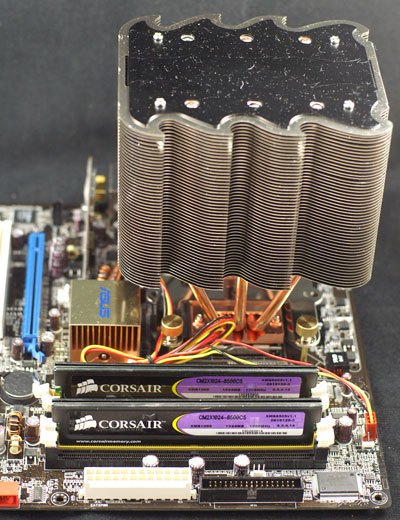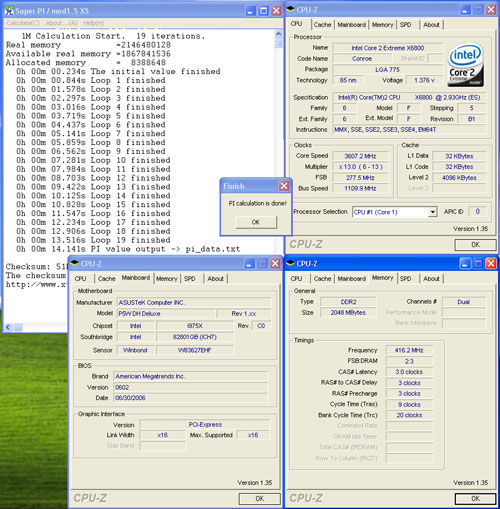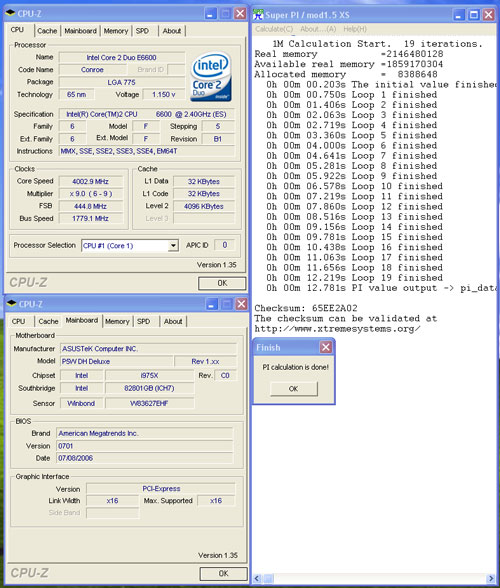Intel's Core 2 Extreme & Core 2 Duo: The Empire Strikes Back
by Anand Lal Shimpi on July 14, 2006 12:00 AM EST- Posted in
- CPUs
Overclocking
You have already seen that the Core 2 Extreme X6800 outperforms AMD's fastest processor, the FX-62, by a wide margin. This is exacerbated by the fact that the $316 E6600, running at 2.4GHz, outperforms the FX-62 in almost every benchmark we ran. That certainly address the questions of raw performance and value.
For most enthusiasts, however, there is also the important question of how Core 2 processors overclock. As AMD has moved closer to the 90nm wall, recent AM2 processors do not have much headroom. A prime example is the FX-62, which is rated at 2.8GHz, reaches 3GHz with ease, but then has a difficult time reaching or passing 3.1GHz on air. So how does Core 2, built at 65nm, compare in overclocking?
The top X6800 is rated to run at 11X multiplier on a 1066MHz FSB; it is the only Core 2, however, that is completely unlocked, both up and down. You can adjust multipliers up to 60 on the Asus P5W-DH motherboard, or down to 6. This makes the X6800 an ideal CPU for overclocking, even though top-line processors are normally notorious for not being the best overclockers.
To gauge the overhead or overclocking abilities of the X6800 in the simplest terms, the CPU speed was increased, keeping the CPU voltage at the default setting of 1.20V.
At default voltage the X6800 reached a stable 3.6GHz (13 x277). This is a 23% overclock from the stock 2.93GHz speed at stock voltage. It is also an important overclocking result, since it implies Intel could easily release a 3.46GHz or 3.6GHz Core 2 processor tomorrow if they chose to. It is clear there is no need for these faster Core 2s yet, but it does illustrate the speed range possible with the current Core 2 Duo architecture.
The X6800 was then pushed to the highest CPU speed we could achieve with Air Cooling. We did use a very popular and effective air cooler for our testing, the Tuniq Tower.

The goal was to reach the highest possible speed that was benchmark stable. Super Pi, 3DMarks, and several game benchmarks were run to test stability. The 2.93GHz chip reached 4.0GHz on air cooling in these overclocking tests. That represents a 36% overclock on air with what will likely be the least overclockable Core 2 processor - the top line X6800.
To provide some idea of overclocking abilities with other Core 2 Duo processors, we ran quick tests with E6700 (2.67GHz), and E6600 (2.4GHz). The test E6700 reached a stable 3.4GHz at default voltage and topped out at 3.9GHz with the Tuniq Cooler. The 2.4GHz E6600 turned out to be quite an overclocker in our tests. Even though it was hard-locked at a 9 multiplier it reached an amazing 4GHz in the overclocking tests. That represents a 67% overclock.
We had another Core 2 Extreme X6800 that we tried overclocking with a stock Intel HSF. The results were not as impressive as with the Tuniq cooler, with 3.4GHz being the most stable we could get it. We're going to be playing around with these processors more in the future to hopefully get a better overall characterization of what you can expect.
Curious about our overclocking successes, we asked Intel why Core 2 CPUs are able to overclock close to the same levels as NetBurst processors can, despite having less than half the pipeline length. Intel gave us the following explanation:
NetBurst microarchitecture is constrained by physical power / thermal limitations long before the constraint of pipeline stages comes into play. The microarchitecture itself would continue to scale upwards if not for the power constraints. (In fact, we have seen Presler overclocked to 6 GHz in liquid nitrogen environments. At that level, power delivery through the power supply & board itself begin to limit further scaling of the processor.)
Intel's explanation makes a great deal of sense, especially when you remember the original claims that NetBurst was supposed to be good for between 5GHz - 10GHz. NetBurst never got the chance to reach its true overclocking prime as Intel hit thermal density walls well before the 5GHz - 10GHz range and thus Intel's Core architecture was born. Intel's Core 2 processors once again give us an example of the good ol' days of Intel overclocking, where moving to a smaller manufacturing process meant we'd have some highly overclockable chips on our hands. With NetBurst dead and buried, the golden age of overclocking is back.
Enthusuasts have not seen overclocking like this since Socket 478 days, and in fact Core 2 may be even better. The 2.4GHz E6600, which outperformed the FX-62 in most benchmarks at stock speed costs $316, and overclocked to 4Ghz with excellent air cooling. With that kind of performance, value, and overclocking the E6600 will likely become the preferred chip for serious overclockers - particularly those that are looking for champagne performance on a smaller budget.
It is important, however, not to sell the advantages of the X6800 short. AnandTech never recommends the fastest chip you can buy as a good value choice, but X6800 does bring some advantages to the table. It is the only Conroe that is completely unlocked. This allows settings like 266(stock FSB)x15 for 4.0GHz, settings that keep other components in the system at stock speed. This can only be achieved with the X6800 - other Core 2 Duo chips are hard-locked - and for some that feature will justify buying an X6800 at $999. For the rest of us overclockers E6600 is shaping up to be the chip to buy for overclocking.












202 Comments
View All Comments
code255 - Friday, July 14, 2006 - link
Thanks a lot for the Rise of Legends benchmark! I play the game, and I was really interested in seeing how different CPUs perform in it.And GAWD DAMN the Core 2 totally owns in RoL, and that's only in a timedemo playback environment. Imagine how much better it'll be over AMD in single-player games where lots of AI calculations need to be done, and when the settings are at max; the high-quality physics settings are very CPU intensive...
I've so gotta get a Core 2 when they come out!
Locutus465 - Friday, July 14, 2006 - link
It's good to see intel is back. Now hopefully we'll be seeing some real innovation in the CPU market again. I wonder what the picture is going to look like in a couple years when I'm ready to upgrade again!Spoonbender - Friday, July 14, 2006 - link
First, isn't it misleading to say "memory latency" is better than on AMD systems?What happens is that the actual latency for *memory* access is still (more or less) the same. But the huge cache + misc. clever tricks means you don't have to go all the way to memory as often.
Next up, what about 64-bit? Wouldn't it be relevant to see if Conroe's lead is as impressive in 64-bit? Or is it the same horrible implementation that Netburst used?
JarredWalton - Friday, July 14, 2006 - link
Actually, it's the "clever tricks" that are reducing latency. (Latency is generally calculated with very large data sets, so even if you have 8 or 16 MB of cache the program can still determine how fast the system memory is.) If the CPU can analyze RAM access requests in advance and queue up the request earlier, main memory has more time to get ready, thus reducing perceived latency from the CPU. It's a matter of using transistors to accomplish this vs. using them elsewhere.It may also be that current latency applications will need to be adjusted to properly compute latency on Core 2, but if their results are representative of how real world applications will perceive latency, it doesn't really matter. Right now, it appears that Core 2 is properly architected to deal with latency, bandwidth, etc. very well.
Spoonbender - Friday, July 14, 2006 - link
Well, when I think of latency, I think worst-case latency, when, for some reason, you need to access something that is still in memory, and haven't already been queued.Now, if their prefetching tricks can *always* start memory loads before they're needed, I'll agree, their effective latency is lower. But if it only works, say, 95% of the time, I'd still say their latency is however long it takes for me to issue a memory load request, and wait for it to get back, without a cache hit, and without the prefetch mechanism being able to kick in.
Just technical nitpicking, I suppose. I agree, the latency that applications will typcially perceive is what the graph shows. I just think it's misleading to call that "memory latency"
As you say, it's architected to hide the latency very well. Which is a damn good idea. But that's still not quite the same as reducing the latency, imo.
Calin - Friday, July 14, 2006 - link
You could find the real latency (or most of it) by reading random locations in the main memory. Even the 4MB cache on the Conroe won't be able to prefetch all the main memory.Anyway, the most interesting is what memory latency the application that run feels. This latency might be lower on high-load, high-memory server processors (not that current benchmarks hint at this for Opteron against server-level Core2)
JarredWalton - Friday, July 14, 2006 - link
"You could find the real latency (or most of it) by reading random locations in the main memory."I'm pretty sure that's how ScienceMark 2.0 calculates latency. You have to remember, even with the memory latency of approximately 35 ns, that delay means the CPU now has approximately 100 cycles to go and find other stuff to do. At an instruction fetch rate of 4 instructions per cycle, that's a lot of untapped power. So, while it waits on main memory access one, it can be scanning the next accesses that are likely to take place and start queuing them up. And the net result is that you may never actually be able to measure latency higher than about 35 ns or whatever.
The way I think of it is this: pipeline issues aside, a large portion of what allowed Athlon 64 to outperform at first was reduced memory latency. Remember, Pentium 4 was easily able to outperform Athlon XP in the majority of benchmarks -- it just did so at higher clock speeds. (Don't *even* try to tell me that the Athlon XP 3200+ was as fast as a Pentium 4 3.2 GHz... LOL.) AMD boosted performance by about 25% by adding an integrated memory controller. Now Intel is faster at similar clock speeds, and although the 4-wide architectural design helps, they almost certainly wouldn't be able to improve performance without improving memory latency -- not just, but in actual practice. With us, I have to think that our memory latency scores are generally representative of what applications see. All I can say is, nice design Intel!
JarredWalton - Friday, July 14, 2006 - link
"...allowed Athlon 64 to outperform at first was...."Should be:
"...allowed Athlon 64 to outperform NetBurst was..."
Bad Dragon NaturallySpeaking!
yacoub - Friday, July 14, 2006 - link
""Another way of looking at it is that Intel's Core 2 Duo E6600 is effectively a $316 FX-62".Then the only question that matters at all for those of us with AMD systems is: Can I get an FX-62 for $316 or less (and run it on my socket-939 board)? If so, I would pick one up. If not, I would go Intel.
End of story.
Gary Key - Friday, July 14, 2006 - link
A very good statement. :)